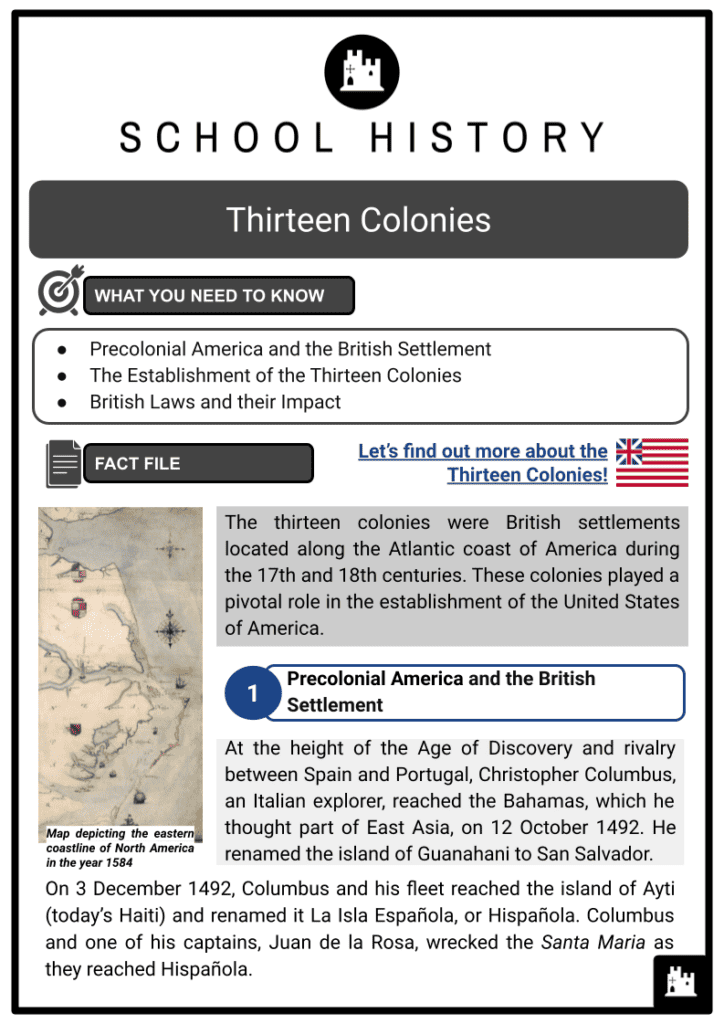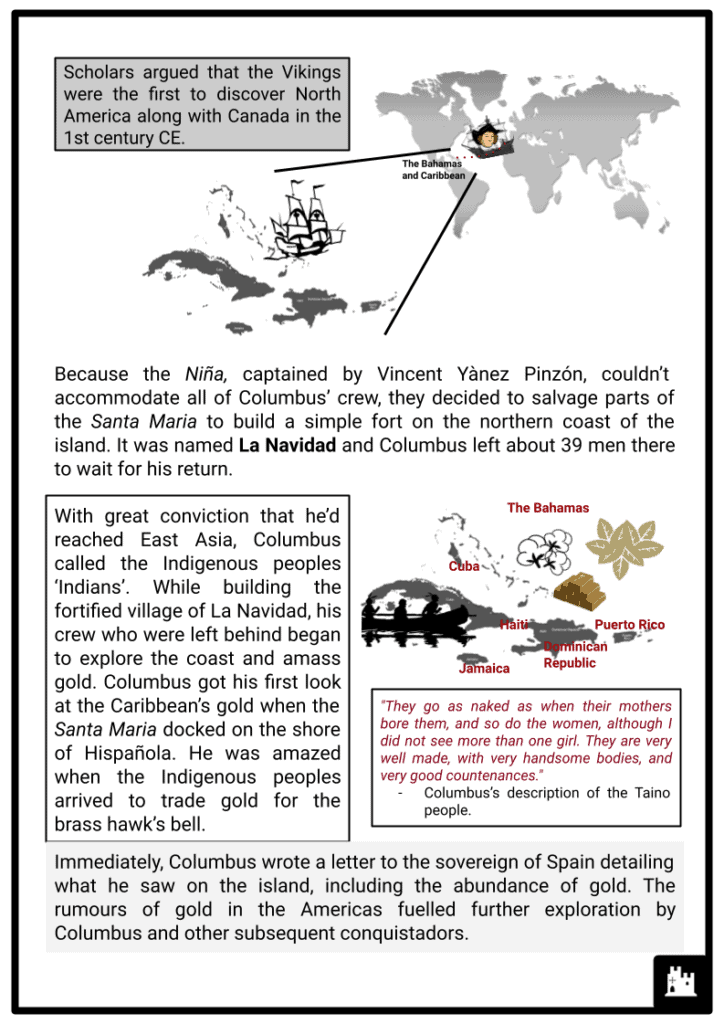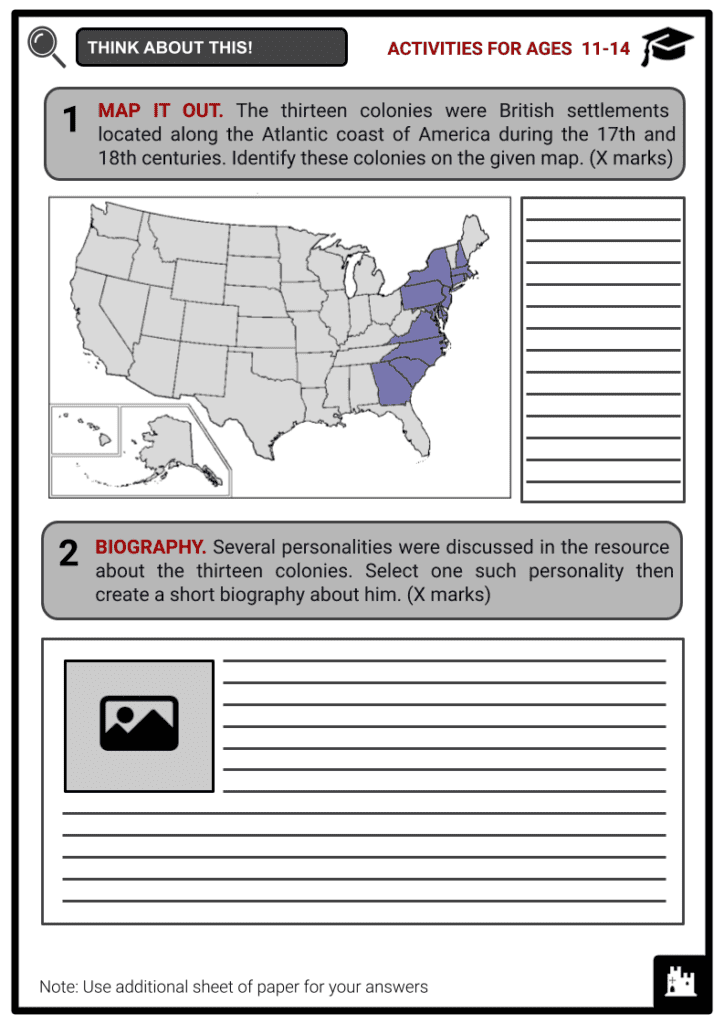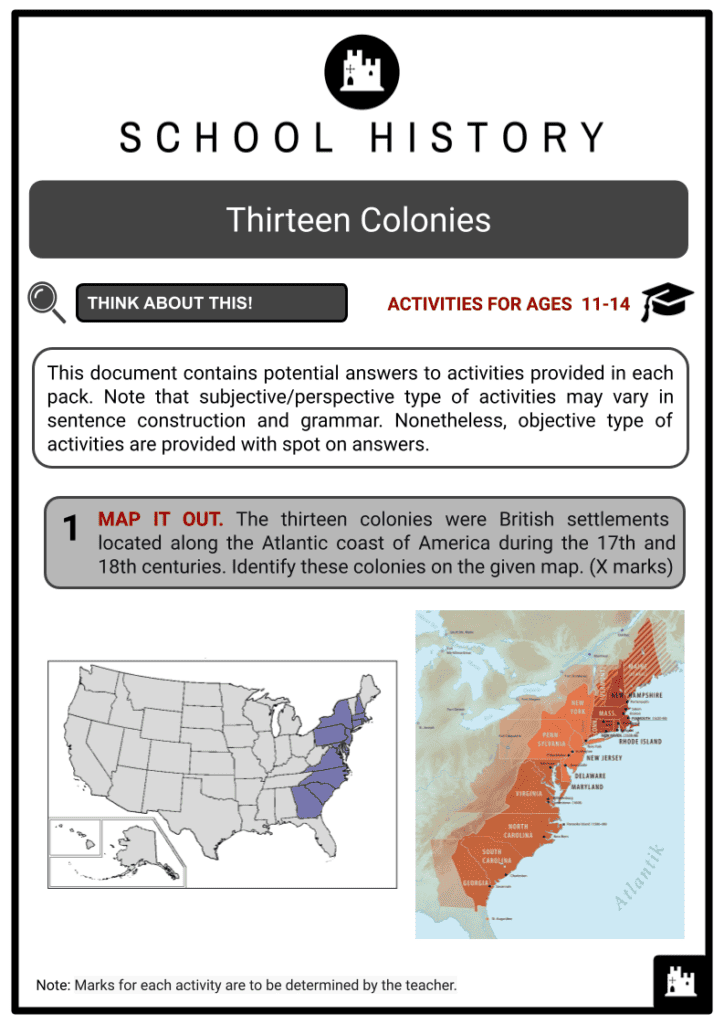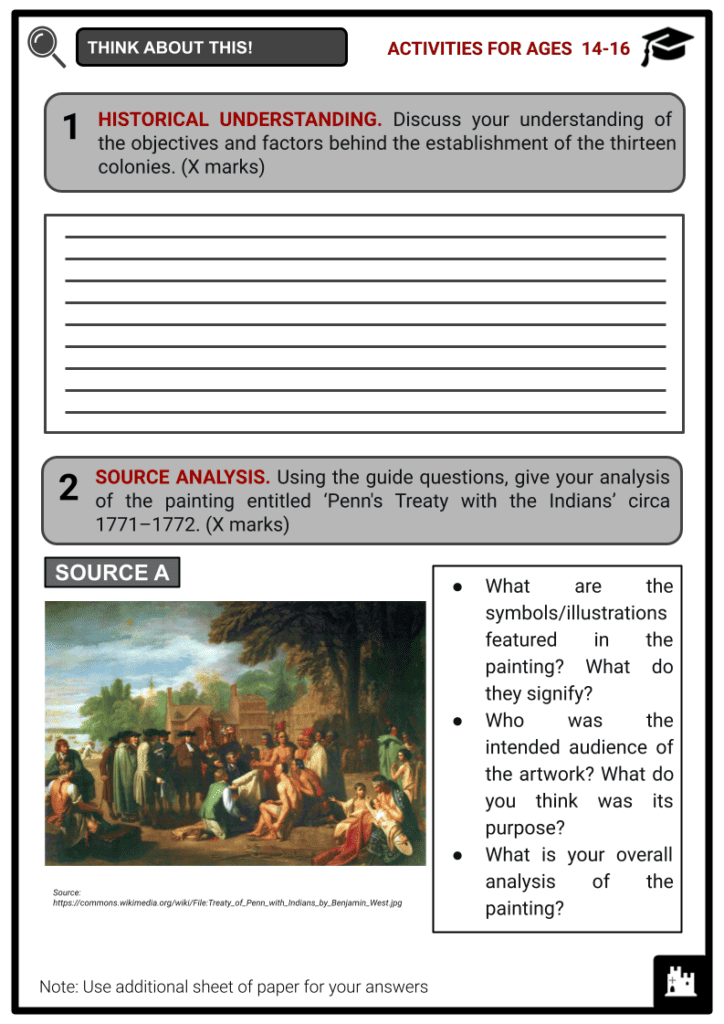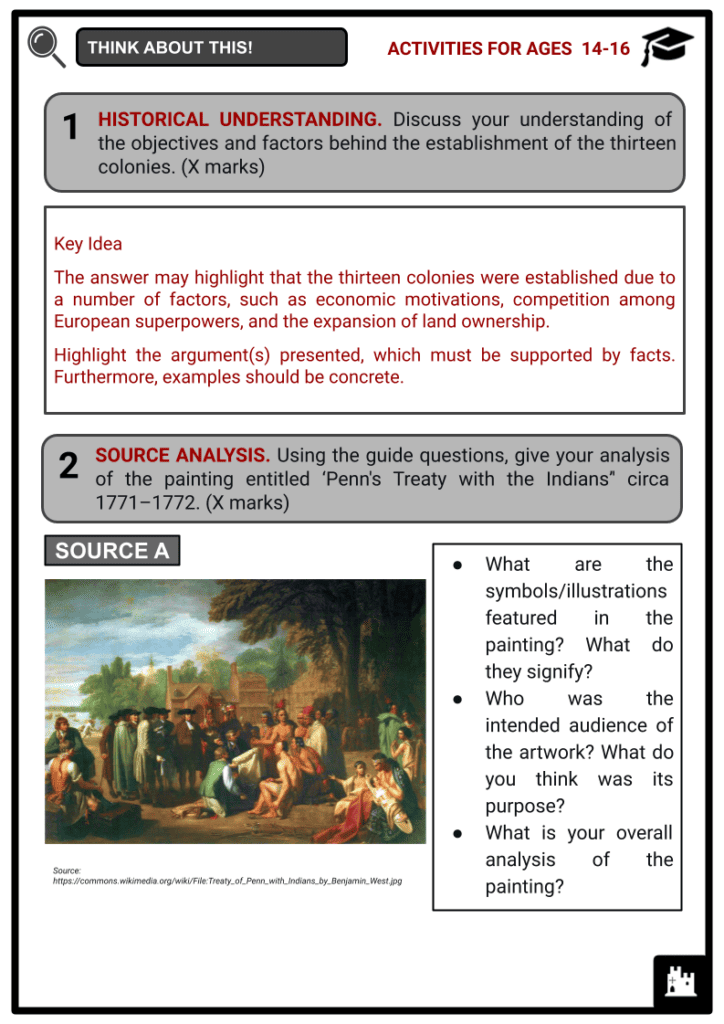Thirteen Colonies Worksheets
Do you want to save dozens of hours in time? Get your evenings and weekends back? Be able to teach about the Thirteen Colonies to your students?
Our worksheet bundle includes a fact file and printable worksheets and student activities. Perfect for both the classroom and homeschooling!
Summary
- Precolonial America and the British Settlement
- The Establishment of the Thirteen Colonies
- British Laws and their Impact
Key Facts And Information
Let’s find out more about the Thirteen Colonies!
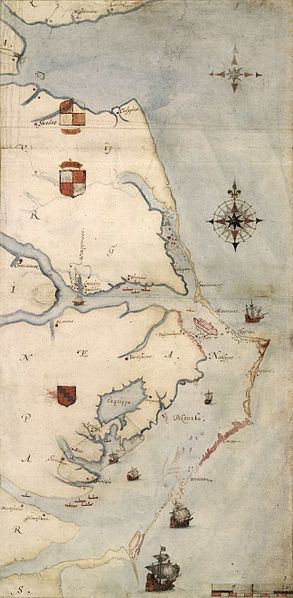
The thirteen colonies were British settlements located along the Atlantic coast of America during the 17th and 18th centuries. These colonies played a pivotal role in the establishment of the United States of America.
Precolonial America and the British Settlement
- At the height of the Age of Discovery and rivalry between Spain and Portugal, Christopher Columbus, an Italian explorer, reached the Bahamas, which he thought part of East Asia, on 12 October 1492. He renamed the island of Guanahani to San Salvador.
- On 3 December 1492, Columbus and his fleet reached the island of Ayti (today’s Haiti) and renamed it La Isla Española, or Hispañola. Columbus and one of his captains, Juan de la Rosa, wrecked the Santa Maria as they reached Hispañola.
- Scholars argued that the Vikings were the first to discover North America along with Canada in the 1st century CE.
- Because the Niña, captained by Vincent Yànez Pinzón, couldn’t accommodate all of Columbus’ crew, they decided to salvage parts of the Santa Maria to build a simple fort on the northern coast of the island. It was named La Navidad, and Columbus left about 39 men there to wait for his return.
- With great conviction that he’d reached East Asia, Columbus called the Indigenous peoples ‘Indians’. While building the fortified village of La Navidad, his crew, who were left behind, began to explore the coast and amass gold. Columbus got his first look at the Caribbean’s gold when the Santa Maria docked on the shore of Hispañola. He was amazed when the Indigenous peoples arrived to trade gold for the brass hawk’s bell.
- Immediately, Columbus wrote a letter to the sovereign of Spain detailing what he saw on the island, including the abundance of gold. The rumours of gold in the Americas fuelled further exploration by Columbus and other subsequent conquistadors.
- In 1493, Columbus set sail on his second voyage to Hispañola with 17 ships and over a thousand men. His aim was to establish a colony and conquer the Americas. On 22 November Columbus reached Hispañola, where he found his men had been killed by the Indigenous peoples and the settlement burnt to the ground. On the coast of Hispañola, where gold was first found, he established the settlement of Isabella before exploring into the interior for gold.
- In the early 17th century, the establishment of British colonies along the coast of North America was launched by James I. The first successful British settlement north of the Spanish-controlled territory of Florida was Jamestown, which was first inhabited by 100 English settlers. However, disease, hunger, and attacks by local Indians diminished their population to 40.
- In 1620, the Mayflower sailed to North America full of English immigrants who later became known as the Pilgrim Fathers. Due to the success of the Plymouth settlers, many Puritans followed and settled in Massachusetts and New England.
- In 1664, New York and New Jersey were granted by Charles II to his brother. Conversely, colonies in New England were run by independent Puritan communities. Other proprietary colonies soon followed, including Carolina and Georgia. In 1681, William Penn, out of royal debt, founded the new colony of Pennsylvania.
- The struggle for power among two European empires – the British and Spanish – led to the colonisation and settlement of the two great American continents. The competition during the Age of Exploration resulted in the expansion and populating of the Americas, specifically the English in the North and Spanish in the South bordering Florida.
REASONS FOR SETTLEMENT
- Early settlements in Massachusetts were founded by English Puritans who strongly believed that it was their duty to convert the Indigenous peoples (who they saw as savages).
- With their underlying religious orientation, towns and villages were organised through congregational churches. Everyday life was restricted by rules and the leadership of ministers. Farming became the main source of production, along with private enterprise and a growing merchant class.
- Meanwhile, those settlements around the Chesapeake Bay area, including Jamestown, Virginia, were explored and established by Captain John Smith in search of material wealth like gold.
- Upon arrival, English settlers struggled to survive. Many were weakened by diseases and fatigue from the long sea voyage. Their general disadvantage in a new environment led to famine, and new settlers’ encounters with the native population resulted in either peace or violence. Those who survived the New World referenced England by naming their surroundings Boston, Northumberland, Middlesex and Cambridge.
- In New England, the colonial authority of governments was contested by the native population of American Indians. In particular, the Powhatan Confederacy established early resistance against the settlers and colonial officials. The same happened in Virginia during the late 17th century when Chesapeake Indigenous peoples led the Bacon’s Rebellion, which overthrew the early colonial government.
- There were Indigenous people such as Squanto who served a notable role in the survival of English settlers. According to legends, Squanto taught the Pilgrims how to plant corn so they could survive the coming winter.
The Establishment of the Thirteen Colonies
- When the English began to establish colonies on the American continent, 13 colonies began to come together to form the United States. These colonies were: New Hampshire, Massachusetts, Connecticut, Rhode Island, New York, New Jersey, Pennsylvania, Delaware, Maryland, Virginia, North Carolina, South Carolina and Georgia.
- In 1606, Jamestown, named after James I, became the first official English settlement in America. Virginia then received the first batch of enslaved Africans in 1619. By 1632, as granted by the English Crown, Maryland, named after the Queen, was established as a colony.
- In 1620, a small group of Pilgrims arrived and settled in the Plymouth colony. After a decade, Massachusetts colony was founded by the Puritans. By 1665, the Puritans had extended to Connecticut, followed by the colonies of Rhode Island and New Hampshire, which formed the New England colonies.
- In 1664, King Charles II granted his brother James, the Duke of York, lands between New England and Virginia, which later became known as New York. Most settlers were Dutch, French, Scandinavian and German.
- In 1680, Quaker William Penn received miles of land west of the Delaware River from the king out of royal debt and founded the new colony of Pennsylvania. Initially, the land became known as the colony of ‘Penn’s Woods’, later Pennsylvania, completing the Middle Colonies.
- In 1729, the colony of Carolina, covering the south from Virginia to Florida, was split into North and South. Given the close ties with English planters of the Caribbean, Carolina developed as a colony highly dependent on slave labour. Inspired by the buffer between the Spanish settlement of Florida and the Carolinas, in 1732, Georgia was founded by James Oglethorpe and joined the Southern Colonies.
- By 1700, the original thirteen colonies were inhabited by about 2,400,000 European and African settlers, in addition to the Indigenous population. The English Crown aimed to expand the empire to counter the growing Spanish power. Trading ports were built along the coast of the Americas that enlarged commerce, trade and employment. Moreover, many colonies, including Pennsylvania, Massachusetts, Maryland, Rhode Island and Connecticut, were founded by charismatic religious leaders seeking freedom, while others were out of economic opportunities.
British Laws and their Impact
- Under British rule, the territories in America were called colonies, provinces or dominions.
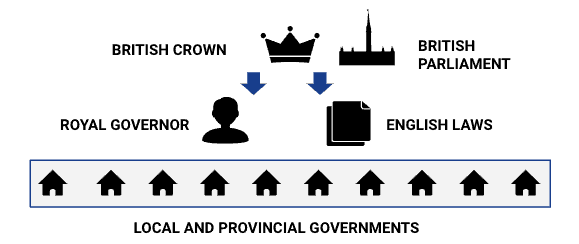
- For each colony, the King appointed royal governors to rule and impose English common law under his name. With limited self-government, local and provincial governments were voted by wealthy landowners subject to the approval of the colony’s governor.
- In most parts of the thirteen colonies, slavery was legal and widely practised. Most enslaved people worked in plantations and households. Among the examples were Virginia and Maryland’s tobacco plantations and South Carolina’s rice and indigo plantations. In the mid-1700s, the colonies developed independent governments and money systems from each other. With the growing population and trade opportunities, the colonists felt restricted by the British mercantilist policies. As a result, colonists began smuggling goods through secret trading with France, Spain and the Netherlands.
- The British Empire imposed the mercantile system in running the economy of the colonies, which meant trading with other empires was forbidden.
BRITISH LAWS
- In the late 1300s, King Richard II restricted imports and exports to be transported only in English-owned ships. As a result of growing smuggling, in 1651, the English Parliament passed the Navigation Acts that generally regulated shipping and maritime commerce of American colonists.
- In 1764, tax was levied on sugar and molasses imported into the colonies through the Sugar Act passed by the British Parliament. The act amended the existing Molasses Act of 1733 that increased duties of imported molasses.
- In 1765, Britain imposed the first explicit tax on American colonists for the purpose of raising revenue as a consequence of the costly Seven Years’ War. The Stamp Act placed tax on printed materials, including pamphlets, newspapers and legal documents. Due to the resounding opposition of the colonists, the act was repealed the following year.
- In order to improve the living conditions of British troops and cut the cost of the Crown, the Quartering Act was passed in 1765, that required colonial assemblies to provide housing and basic care to the troops.
- Another revenue-driven act was passed in 1767, the Townshend Acts that levied duties on 72 items, such as paint, tea, paper and glass. Moreover, it established the American Customs Boards that ignited colonists’ resistance and resulted in the bloody incident in Boston.
- In 1773, the Tea Act granted the East India Company sole right to import and distribute tea in the thirteen colonies. As a result, smugglers increased, and by December, a number of Bostonians dumped hundreds of chests of tea into the harbour, which later became known as the Boston Tea Party.
- As punishment to the colonists, especially in Boston, the British Parliament passed the Intolerable Acts in 1774. Also known as the Coercive Acts, it consisted of five laws, including the Boston Port Act, Massachusetts Government Act, Administration of Justice Act, Quartering Act, and Quebec Act.
IMPORTANT TREATIES
1763 PEACE TREATY OF PARIS
- The treaty officially ended the Seven Years’ War, also known as the French and Indian War between Great Britain and France, including its respective Indigenous allies. As a result of the treaty, France gave up territories in North America, specifically all French-controlled lands east of the Mississippi. Moreover, the treaty also gave Spanish Florida to Great Britain, while French territories west of Mississippi would become Spanish.
- Among the impact of the French and Indian War was the expansion of British territories in North America. However, this costly war also resulted in the British imposition of taxes on the colonists.
- In 1765 and 1783, the American Revolution occurred, during which colonists in the Thirteen American Colonies rejected the British monarchy and aristocracy, overthrew the authority of Great Britain, and founded the United States of America. An essential part of this was the Declaration of Independence signed by the Congressional Representatives of the Thirteen Colonies on 4 July 1776, which particularly emphasised individual rights and self-government. The Declaration of Independence essentially declared war on King George III and Great Britain.
1763 ROYAL PROCLAMATION
- In his attempt to prevent similar situations like Pontiac’s rebellion, King George III of Britain issued a royal proclamation. The proclamation established four new mainland colonies of Quebec, West Florida, East Florida and Grenada, which extended southern Georgia’s border. Moreover, soldiers who had fought during the Seven Years’ War were given land. Furthermore, the proclamation limited trade with Indigenous peoples to licensed traders. Such limitation enabled the British to monopolise the fur trade with the Indigenous peoples.
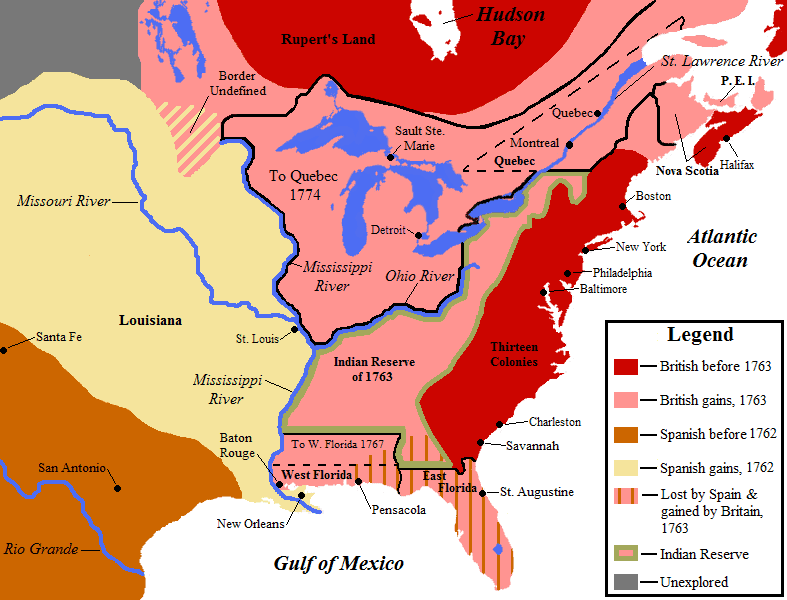
- On 7 October 1763, a royal proclamation was made by King George III following the British victory over France in the French and Indian Wars. It was designed to halt any expansion and settlement of colonists to the west, which was perceived as beneficial to the Indigenous peoples and detrimental to colonists.
- As seen on the map, the Proclamation line served as the boundary line between the British colonies on the Atlantic coast of America and American Indigenous land. It ran west of the Appalachian Mountains and south of Hudson Bay in Florida. In order to enforce the boundary, the British Administration made a costly venture to establish posts along the border.
- The colonists reacted negatively since the cost of such action was imposed on them through taxation. They resented the proclamation and joined land speculators in Britain to lobby the government. They specifically wanted to move the line further west, which was then adjusted after a series of treaties with the Indigenous peoples.
1783 TREATY OF PARIS
- The peace treaty was signed on 3 September 1783, officially ending the American Revolutionary War between the American colonies and Britain. On 14 January 1784, the Confederate Congress ratified it, followed by King George III three months later.
- The treaty pointed to the following terms:
- British acknowledgement of American independence.
- The American territory defined from the Great Lakes to the 31st parallel latitude from the Atlantic to the Mississippi, thus enabling westward expansion.
- The Americans agreed to end the persecution of loyalists and to restore any properties confiscated during the war.
- Both parties agreed not to block creditors from collecting debts.
- All prisoners of war would be released.
- American fishermen’s access to the Grand Banks and Canadian waters.
- Freedom to navigate the Mississippi River by both parties.
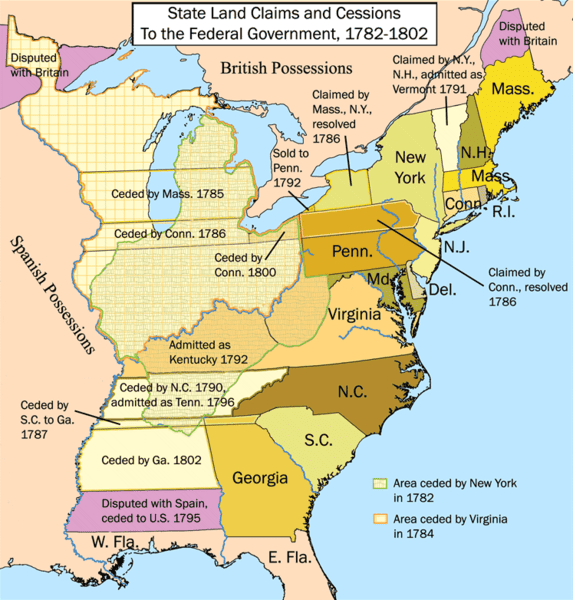
Map showing the United States territory after the Treaty of Paris in 1783
- Treaties were also arranged with France, the Dutch Republic, Spain, and the American colony. Spain had joined the war with the colonists and France. During the peace accord, Spain retained control of Florida. As per the map, the United States (American colonies) obtained western lands, bounded to the south by Spanish Florida and to the west by Spanish Louisiana.
- After the treaty, British troops remained at their stations at six forts in the Great Lakes region. By 1794, they had built additional forts in present-day Ohio, but these were later relinquished under the Jay Treaty.
Frequently Asked Questions
- What were the Thirteen Colonies?
The Thirteen Colonies were a group of British colonies on the eastern coast of North America, established between the 17th and 18th centuries. They later became the original states of the United States of America after the American Revolution.
- When were the Thirteen Colonies established?
The first colony, Virginia, was established in 1607, and the last colony, Georgia, was established in 1733. Over this period, the Thirteen Colonies were founded, each for different reasons, including economic opportunity, religious freedom, and political autonomy.
- What role did the Thirteen Colonies play in the American Revolution?
The Thirteen Colonies were the main battleground during the American Revolution (1775-1783). The colonists, dissatisfied with British policies and seeking independence, fought against the British forces. The Revolution resulted in the Thirteen Colonies gaining independence and forming the United States of America.

